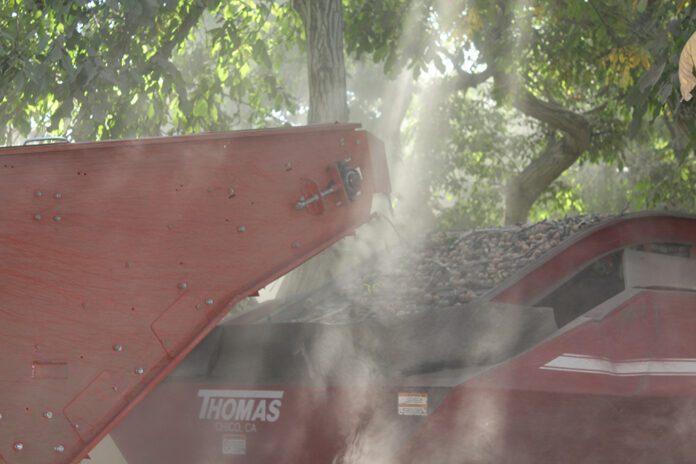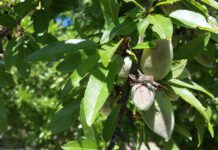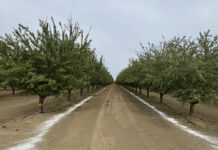Were some postharvest nutrition applications in your almond orchards abandoned last fall? Depending on what was skipped, there may be consequences to production and tree health going forward if nutrition adjustments are not made during the next growing season.
Crop advisor John Post with Agricultural Advisors said there are still chances in February and even later in the growing season to catch up with applications of micronutrients like boron and zinc as well as with potassium and nitrogen. He said if leaf samples show nutrition levels trending down over time, efforts should be made to correct before deficiency occurs.
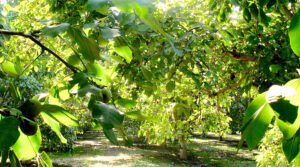
Rich Kreps, crop advisor with Ultra Gro, said catching up late with nutrition can help make things like fruit set and yield better, but yield has already been affected if nutrition was skipped in late summer and early fall.
“You can help size and stick a crop, but damage has already been done as bud differentiation mostly happened in late summer,” Kreps said.
Boron Deficiency Effects
Post explained there are two different deficiencies with B: one with the plant and the other with the flower bud. There are generally sufficient B supplies in the tree, but a deficiency in the flower bud is common and can cause yield consequences. In-season leaf tissue analysis can show if the tree is deficient. Post said if B levels are below 150 ppb, fertigation with B in the fall or in the spring can help correct the deficiency in the tree. A foliar application of B can be done from postharvest to flowering to help with deficiency of the flower.
Post said B deficiency of the flower, determined by harvest hull sample analysis, can decrease fruit set in a couple of different ways. First, it can lower pollen viability and germination and reduce the rate of pollen tube development. B deficiency can also decrease the transport of sugars to the flower, which can decrease the attractiveness of pollen to bees. He noted there is research that shows B applications postharvest to the bud and all the way up until the popcorn stage can greatly increase fruit set.
Some almond growing regions like the west side of the Sacramento Valley have high levels of B in groundwater. But, Post noted, even if B levels in the leaf samples are slightly toxic, there can still be deficiency in the flowers.
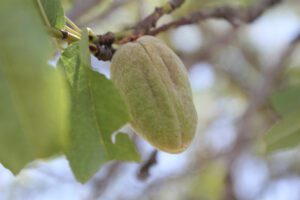
Effect of Zinc, Potassium Deficiency
Z deficiency can decrease the production of carbohydrates in the tree, Post said. Z deficiency is becoming more of an issue recently because some newer rootstocks are not as efficient in mining Z, and some varieties, namely Independence, seem to need more zinc. The decrease in carbohydrate production, Post explained, is important because this micronutrient assists with several enzymatic processes, which can lead to defoliation and shoot death. Small, curled leaves are a sign of Z deficiency, which plays a role in auxin formation and helps produce normal-sized leaves, shoots and fruit. Z is critical for carbohydrate production that leads to nut fill and stress responses that can avoid other quality issues. It’s worthwhile to correct a deficiency, but for orchards that are not deficient, a spray is probably not worth the investment this year.
K is best applied dry in the fall also as winter rains can help it move through the soil. Spring feeding is more of a ‘Band-Aid,’ Post said. If a K deficiency is present, and not corrected with a fall application, it should be added to the first irrigation and slowly applied throughout the growing season. Post said K is very important in increasing the concentration of carbohydrates to the fruit. In K-deficient situations, a decrease in nut size is evident. Potassium also activates enzymes and plays a major role in water relations and plant resistance to pests and diseases.
N is not always applied postharvest unless there was a heavy crop that removed more N than normal or leaf samples have shown a deficiency. If a small shot of N was not done postharvest, Post said at beginning of leaf-out, it should be applied with first irrigation with a goal of replenishing by mid-June.
Research done by UCCE Farm Advisor Franz Niederholzer suggests late postharvest N applications can be skipped if mid-July leaf levels are adequate. Trials conducted at the Nickels Soil Lab in Colusa County found no negative impact on production when skipping postharvest N within orchards. In this trial, Almond Doctor David Doll reported trees had leaf N values of 2.55% or greater mid-July.
Doll reported K fertility management is different than that of N. This nutrient moves into the root through diffusion and mass flow. This means it must be within the active root zone to be utilized by the tree. K is a cation and will respond differently based on soil type. Doll said high-cation-exchange-capacity (CEC) soils can prevent K from being available to the plant. In low CEC soils, the opposite is true and results in higher K uptake. In this situation, more K can leach below the rootzone.
Katherine Jarvis-Shean, UCCE orchard systems advisor in Sacramento, Solano and Yolo counties, noted in Sacramento Valley Walnut News that sensitivity to a lack of N will vary from orchard to orchard. Forcing deficiency on young trees impacts growth of future nut-bearing branches, delaying future yield potential. Older trees will have more tissue in which N may have been stored from previous years, so will be more resilient to decreased N applications, making them better candidates for decreased N applications during cost-cutting times.


